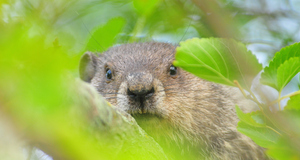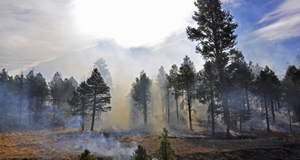From Discussions VOL. 5 NO. 2Effects of Simulated Deer Browsing Intensity and Fragmentation on Regenerative Dynamics of Acer saccharum Marsh. (Sugar Maple) Plants in Temperate ForestsResultsPlant level responsesAt the plant level, the separate and interactive effects of deer browsing intensity and fragmentation were generally not detected (Table 1). However, plant volume was affected by an interaction involving fragmentation and time (p = 0.049). In 2008, plant volume in edge habitats was 32% greater than that in forest interiors (Tukey-Kramer p = 0.007, Figure 1, next page). Additionally, while an interactive effect of time, fragmentation, and browsing intensity on the number of branches per plant was detected (p = 0.021), this was attributed to changes over time in edge habitats receiving low clipping and interior habitats receiving high clipping (Tukey-Kramer p = 0.003 and p = 0.012 respectively) as well as a difference in edge habitats receiving low clipping in 2007 versus interior habitats receiving high clipping in 2008 (Tukey-Kramer p = 0.050). Table 1: Sources of variation and P values for fixed effects following ANCOVA that was used to examine plant level effects of simulated deer browsing intensity and fragmentation on juvenile sugar maple plants.
Figure 1: Mean (± SE) volume of juvenile sugar maple plants in forest edge and interior habitats before (2006) and after (2007, 2008) simulated deer browsing intensity.
Branch level responsesFragmentation, alone, affected branch level responses of juvenile plants (Table 2). Specifically, fragmentation influenced bud (p = 0.053) and leaf (p = 0.037) production. Plants in edge habitats had 45% more buds than those in forest interiors (Figure 2a). Similarly, plants near a forest edge had 53% more leaves than those located in forest interior habitats (Figure 2b). Table 2: Sources of variation and P values for fixed effects following ANCOVA that was used to examine branch level effects of simulated deer browsing intensity and fragmentation on juvenile sugar maple plants.
Figure 2: Mean (± SE) number of (a) buds per branch and (b) leaves per branch for juvenile sugar maple plants in forest edge and interior habitats before (Pre-treatment) and after (Post-treatment) simulated deer browsing intensity.
DiscussionCompared to plants in forest interiors, plants had greater volume as well as more leaves and buds in forest edge habitats where light levels are likely elevated (Euskirchen et al. 2000). Since our edges were ~100 years old, these results were unexpected. Light levels in forest edge habitats usually diminish after 40-50 years; edges "close up" following adventitious lateral growth of canopy adults near such edges (Matlack 1994). In contrast, our fragmented sites likely remained open, causing plant growth and regeneration. At our sites, a single natural deer browsing event at various intensities did not affect growth and regeneration of juvenile sugar maple plants. In contrast to our results, woody plants have demonstrated in the past overcompensation of growth after levels of simulated browsing intensity (Bergstrom and Danell 1987, Danell 1985, Hjalten et al. 1993). This response may represent an attempt to escape a ruminant browse line (Bergstrom and Danell 1987) or maintain a constant root to shoot ratio (Danell et al. 1985). Alternatively, overall plant growth can decrease (Puetmann and Saunders 2001), possibly due to a decrease in competitive ability (Augner et al. 1997). We did not observe either of these changes perhaps because our browsing intensity treatments did not involve unnatural levels of plant defoliation using arbitrary percentages. Regenerative dynamics of juvenile sugar maple plants may be affected by other characteristics of a deer browsing regimen, including seasonal timing, and frequency (Pickett and White 1985). Seasonal timing of browsing can affect plant responses (Hjalten et al. 1993). Plants browsed in the early summer have a greater response to clipping than those browsed in winter or late summer (Reich et al. 1993). Little knowledge about the effects of browsing frequency on plant regeneration is available because most browsing studies do not imitate natural frequencies and only clip once a year (see Bergstrom and Danell 1987). Information about the effects of seasonal timing and browsing frequency is crucial in accurately simulating browsing regimens and could help researchers better understand how natural browsing affects woody plant regeneration. We therefore suggest two lines of research that would help elucidate the natural effects of deer browsing on woody plant regeneration. The first is to begin research projects in line with the projects of Shipley and Spalinger (1995) to gain a deeper understanding of deer browsing regimens. In order to understand deer browsing regimen, more research is needed on the frequency and seasonal timing that deers browse woody plants. After the deer browsing regimen is understood, we can more accurately research the effects of natural browsing on plants to then know how to most appropriately manage deer populations in temperate forests. AcknowledgmentsI would like to thank Dr. Paul Drewa for all his advice, direction, editing, and discussions, Sandra Albro for the immense amount of help and advice, and Sheryl Petersen for helpful discussions of ideas. I would also like to extend a special thanks to The Holden Arboretum and Summit County Metro Parks for access to sites. This research was funded by the Howard Hughes Memorial Institute's SPUR program through Case Western Reserve University and the Holden Arboretum. ReferencesAlverson, W.S., Waller, D.M, Solheim, S.L., 1988. Forests Too Deer: Edge Effects in Northern Wisconsin. Conservation Biology 2, 4, 348-358. Anderson, R.C. and O.L. Louks. 1979. White-tailed deer (Odocoileus virginianus) influence on structure and composition of Tsuga canadensis forests. Journal of Applied Ecology, 16: 855-861. Augner, M., Tuomi, J., and M. Rousi. 1997. Effects of defoliation on competitive interactions in European white birch. Ecology, 1: 2369-2377. Baldwin, I.T. 1990. Herbivory simulations in ecological research. Trends in Ecology and Evolution, 5: 91-93. Bergstrom, R. and K. Danell. 1987. Effects of simulated winter browsing by moose on morphology and biomass of two birch species. The Journal of Ecology, 75: 533-544. Bergstrom, R. and K. Danell. 1995. Effects of simulated summer browsing by moose on leaf and shoot biomass of birch, Betula pendula. Oikos, 72: 132-138. Braun, E.L., 1950. Deciduous Forests of Eastern North America. The Blackiston Company, Philadelphia. Canham, C.D., McAninch, J.B., and D.M. Wood. 1994. Effects of the frequency, timing, and intensity of simulated browsing on growth and mortality of tree seedlings. Canadian Journal of Forest Research, 24: 817-825. Chen, J., Franklin, J.F., Spies, T.A., 1992. Vegetation Responses to Edge Environments in Old-Growth Douglas-Fir Forests. Ecological Applications 2, 4, 387-396. Cooper, S.M., Owens, M.K., Spalinger, D.E., and T.F. Ginnett. 2003. The architecture of shrubs after defoliation and the subsequent feeding behavior of browsers. OIKOS, 100: 387-393. Danell, K., Bergstrom, R., and L. Edenius. 1994. Effects of large mammalian browsers on architecture, biomass, and nutrients of woody plants. Journal of Mammalogy, 75: 833-844. Euskirchen, E.S., Chen, J., Bi, R., 2007. Effects of edges on plant communities in a managed landscape in northern Wisconsin. Forest Ecology and Management 148, 93-108. Frelich, L.E. and C.G. Lorimer. 1985. Current and predicted long-term effects of deer browsing in hemlock forests in Michigan, USA. Biological Conservation, 34: 99-120. Harmer, R. 2001. The effect of plant competition and simulated summer browsing by deer on tree regeneration. Journal of Applied Ecology, 38: 1094-1103. Hjalten, J., Danell, K., and L. Ericson. 1993. Effects of simulated herbivory and intraspecific competition on the compensatory ability of birches. Ecology, 74: 1136-1142. Johnson, A.S., Hale, P.E., Ford, W.M., Wentworth, J.M., French, J.R., Anderson, O.F., and G.B. Pullen. 1995. Whitetailed deer foraging in relation to successional stage, overstory type and management of southern Appalachian forests. American Midland Naturalist, 133: 18-35. Matlack, G.R., 1994. Vegetation Dynamics of the Forest Edge -Trends in Space and Successional Time. The Journal of Ecology 82, 1, 113-123. McLaren, B.E. 1996. Plant-specific responses to herbivory: Simulated browsing of suppressed balsam fir on Isle Royale. Ecology, 77: 228-235. Murcia, C., 1995. Edge effects in fragmented forests: implications for conservation. Tree 10, 2, 58-62. NCDC, 2004. National Climate Data Center. Accessed June 2008. http://cdo.ncdc.noaa.gov/ climatenormals/clim20/statepdf/oh.pdf. Pickett, S.T.A. and P.S. White, 1985. The Ecology of Natural Disturbance and Patch Dynamics. Academic Press Inc., San Diego. Poulsen, T.L., Platt, W.J., 1996. Replacement patterns of beech and sugar maple in Warren Woods, Michigan. Ecology 77, 1234-1253. Puettmann, K.J. and M.R. Saunders. 2001. Patterns of growth compensation in eastern white pine (Pinus strobes L.): The influence of herbivory intensity and competitive environments. Oecologia, 129: 376-384. Rooney, T.P., Waller, D.M., 2003. Direct and indirect effects of white-tailed deer in forest ecosystems. Forest Ecology and Management 181, 165-176. Russell, F.L., Zippin, D.B., and N.L. Fowler. 2001. Effects of white-tailed deer (Odocoileus virginianus) on plants, plant populations, and communities: A review. American Midland Naturalist, 146: 1-26. SAS Institute Inc., 2004. SAS/STAT 9.1 User's Guide. SAS Publishing, Cary, NC. Saunders, D.A., Hobbs, R.J., Margules, C.R., 1991. Biological Consequences of Ecosystem Fragmentation: A Review. Conservation Biology 5, 1, 18-32. Saunders, M.R. and K.J. Puettmann. 1999a. Effects of overstory and understory competition and simulated herbivory on growth and survival of white pine seedlings. Canadian Journal of Forest Research, 29: 536-546. Saunders, M.R. and K.J. Puettmann. 1999b. Use of vegetational characteristics and browsing patterns to predict deer damage in eastern white pine (Pinus strobus) plantations. Northern Journal of Applied Forestry, 16: 96-102. Shipley, L.A. and D.E. Spalinger. 1995. Influence of size and density of browse patches on intake rates and foraging decisions of young moose and white-tailed deer. Oecologia, 104: 112-121. Strauss, S.Y. 1988. Determining the effects of herbivory using naturally damaged plants. Ecology, 69: 1628-1630. Strole, T.A. and R.C. Anderson. 1992. White-tailed deer browsing: Species preferences and implications for Central IL forests. Natural Areas Journal 12: 139-144. Williamson, S.J. and D.H. Hirth. 1985. An evaluation of edge use by white-tailed deer. Wildlife Society Bulletin, 13: 252257. Suggested Reading from Inquiries Journal
Inquiries Journal provides undergraduate and graduate students around the world a platform for the wide dissemination of academic work over a range of core disciplines. Representing the work of students from hundreds of institutions around the globe, Inquiries Journal's large database of academic articles is completely free. Learn more | Blog | Submit Latest in Biology |























